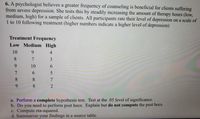
MATLAB: An Introduction with Applications
6th Edition
ISBN: 9781119256830
Author: Amos Gilat
Publisher: John Wiley & Sons Inc
expand_more
expand_more
format_list_bulleted
Concept explainers
Topic Video
Question

Transcribed Image Text:6. A psychologist believes a greater frequency of counseling is beneficial for clients suffering
from severe depression. She tests this by steadily increasing the amount of therapy hours (low,
medium, high) for a sample of clients. All participants rate their level of depression on a scale of
1 to 10 following treatment (higher numbers indicate a higher level of depression)
Treatment Frequency
Low Medium High
10
9.
4
8.
7
3
9.
10
6.
6.
8.
8.
7
9.
8.
a. Perform a complete hypothesis test. Test at the .05 level of significance.
b. Do you need to perform post hocs. Explain but do not compute the post hocs.
c. Compute eta-squared.
d. Summarize your findings in a source table.
Expert Solution
This question has been solved!
Explore an expertly crafted, step-by-step solution for a thorough understanding of key concepts.
Step by stepSolved in 4 steps with 1 images

Knowledge Booster
Learn more about
Need a deep-dive on the concept behind this application? Look no further. Learn more about this topic, statistics and related others by exploring similar questions and additional content below.Similar questions
- 2arrow_forwardA survey asked students for their college and their satisfaction with their program. The results are provided in the tables below. Determine if there is a relationship between college and satisfaction at the 0.05 level of significance. Satisfied Not Satisfied Arts and Sciences 5 2 Education 6 1 Technology 14 12 Business 18 12 Health Profession 10 4 Social and Behavioral Sciences 8 12 H0: College and Satisfaction are independent. H1 : College and Satisfaction are dependent. Determine the p-value. What is the correct decision for this test? What is your conclusion, in context? Explain your reasoning.arrow_forwardAcne is a common skin disease that affects most adolescents and can continue into adulthood. A study compared the effectiveness of three acne treatments and a placebo, all in gel form, applied twice daily for 12 weeks. The study's 517 teenage volunteers were randomly assigned to one of the four treatments. Success was assessed as clear or almost clear skin at the end of the 12 week period. The results of the study can be seen in the table below. Using the appropriate statistical test, determine if there is significant evidence that the four treatments perform differently. If so, how do they compare.arrow_forward
- Part 1 of 4 A doctor in Oklahoma City wants to know whether the average life span for heart disease patients at four hospitals in the city differ. The data below represents the life span, in years, of heart disease patients from each hospital. Perform an ANOVA test with a 10% level of significance to test whether the average life span of heart disease patients in Oklahoma City differs depending on the hospital that treats them Life Span of Patients Treated at Hospital 1: 8.1, 1.2, 7, 11.5, 21, 2, 15.3, 19.2, 10.5, 15.4, 12.7, 15.3, 12.1, 7.5, 11.4, 16.4, 26.7, 14.6, 1.5, 16.3, 12.6, 0.8, 18.2, 4.2, 9.6, 21, 16.3, 2.7 Life Span of Patients Treated at Hospital 2: 17.6, 11.6, 16.8, 5.2, 6.7, 3.2, 13.8, 12.5, 0.9, 6, 14.3, 1.8, 14.8, 10, 5.8, 15.2, 10, 3.7, 11.4, 21.6, 12.9, 0.5, 9.2, 13.9, 10.9 Life Span of Patients Treated at Hospital 3: 8.5, 2.3, 11, 7.4, 14.8, 5.8, 11, 3.4, 10.9, 1.1, 5.9, 21.6, 12.5, 0.1, 15.5, 15.4, 0.8, 7.7, 5.6, 12, 7.1 Life Span of Patients Treated at Hospital 4:…arrow_forward5.Stocks and Mutual Fund Ownership It has been found that 51.4% of U.S. households own stocks and mutual funds. A random sample of 300 heads of households indicated that 178 owned some type of stock. At what level of significance would you conclude that this was a significant difference? Use the P-value method. Assume the variable normally distributed. Use a graphing calculator. Find the P-value. At what level of significance is this a significant difference?arrow_forwardWhat is the turkey HSD for week 0 and week 4 comparison?arrow_forward
arrow_back_ios
arrow_forward_ios
Recommended textbooks for you
 MATLAB: An Introduction with ApplicationsStatisticsISBN:9781119256830Author:Amos GilatPublisher:John Wiley & Sons Inc
MATLAB: An Introduction with ApplicationsStatisticsISBN:9781119256830Author:Amos GilatPublisher:John Wiley & Sons Inc Probability and Statistics for Engineering and th...StatisticsISBN:9781305251809Author:Jay L. DevorePublisher:Cengage Learning
Probability and Statistics for Engineering and th...StatisticsISBN:9781305251809Author:Jay L. DevorePublisher:Cengage Learning Statistics for The Behavioral Sciences (MindTap C...StatisticsISBN:9781305504912Author:Frederick J Gravetter, Larry B. WallnauPublisher:Cengage Learning
Statistics for The Behavioral Sciences (MindTap C...StatisticsISBN:9781305504912Author:Frederick J Gravetter, Larry B. WallnauPublisher:Cengage Learning Elementary Statistics: Picturing the World (7th E...StatisticsISBN:9780134683416Author:Ron Larson, Betsy FarberPublisher:PEARSON
Elementary Statistics: Picturing the World (7th E...StatisticsISBN:9780134683416Author:Ron Larson, Betsy FarberPublisher:PEARSON The Basic Practice of StatisticsStatisticsISBN:9781319042578Author:David S. Moore, William I. Notz, Michael A. FlignerPublisher:W. H. Freeman
The Basic Practice of StatisticsStatisticsISBN:9781319042578Author:David S. Moore, William I. Notz, Michael A. FlignerPublisher:W. H. Freeman Introduction to the Practice of StatisticsStatisticsISBN:9781319013387Author:David S. Moore, George P. McCabe, Bruce A. CraigPublisher:W. H. Freeman
Introduction to the Practice of StatisticsStatisticsISBN:9781319013387Author:David S. Moore, George P. McCabe, Bruce A. CraigPublisher:W. H. Freeman

MATLAB: An Introduction with Applications
Statistics
ISBN:9781119256830
Author:Amos Gilat
Publisher:John Wiley & Sons Inc

Probability and Statistics for Engineering and th...
Statistics
ISBN:9781305251809
Author:Jay L. Devore
Publisher:Cengage Learning

Statistics for The Behavioral Sciences (MindTap C...
Statistics
ISBN:9781305504912
Author:Frederick J Gravetter, Larry B. Wallnau
Publisher:Cengage Learning

Elementary Statistics: Picturing the World (7th E...
Statistics
ISBN:9780134683416
Author:Ron Larson, Betsy Farber
Publisher:PEARSON

The Basic Practice of Statistics
Statistics
ISBN:9781319042578
Author:David S. Moore, William I. Notz, Michael A. Fligner
Publisher:W. H. Freeman

Introduction to the Practice of Statistics
Statistics
ISBN:9781319013387
Author:David S. Moore, George P. McCabe, Bruce A. Craig
Publisher:W. H. Freeman